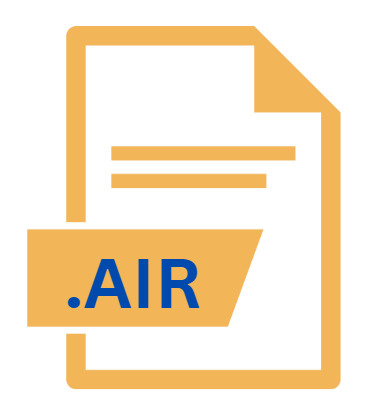.AIR File Extension

Adobe AIR Installation Package
| Developer | Adobe Systems |
| Popularity | |
| Category | Executable Files |
| Format | .AIR |
| Cross Platform | Update Soon |
What is an AIR file?
The .AIR file extension stands for Adobe AIR Installation Package, which is used to distribute and install applications developed on the Adobe AIR (Adobe Integrated Runtime) platform.
Adobe AIR is a cross-platform runtime environment that allows developers to create rich internet applications (RIAs) that can run as standalone applications on desktop and mobile devices.
The .AIR file contains the application package, including the executable code, assets, and metadata necessary for installation and execution on an Adobe AIR-enabled environment.
More Information.
Adobe AIR was first released in 2008, and the .AIR file format was introduced as the standard packaging format for applications developed using this platform.
The primary purpose of the .AIR file was to provide a simple and standardized way to package, distribute, and install applications across multiple operating systems.
This was especially beneficial for developers who wanted to create applications with rich user interfaces and offline capabilities, without being constrained by the limitations of web browsers.
Initially, Adobe AIR was envisioned as a way to bring web technologies to the desktop, enabling developers to leverage their existing skills in web development to create desktop applications.
Over time, Adobe AIR expanded its reach to mobile platforms, allowing developers to create applications that could run on smartphones and tablets in addition to desktop computers.
Origin Of This File.
The .AIR file extension is intrinsically linked to Adobe AIR, which was developed by Adobe Systems to enable developers to deploy web applications as native desktop applications.
Adobe AIR supports various technologies such as HTML, JavaScript, Adobe Flash, and ActionScript, making it a versatile platform for creating engaging and interactive applications that can run consistently across different operating systems.
File Structure Technical Specification.
The .AIR file is essentially a compressed archive that contains all the necessary components required for the application to function. The file structure typically includes the following elements:
- Application Descriptor File: This XML file contains metadata about the application, such as its name, version, description, and the minimum version of Adobe AIR required to run the application. It also specifies the entry point of the application, which is usually an HTML, SWF, or other compatible file.
- Application Code: This includes the executable code of the application, which could be written in ActionScript, JavaScript, or other supported languages.
- Assets and Resources: These are the multimedia files, such as images, videos, and audio, as well as other resources like CSS stylesheets, fonts, and XML files, which are used by the application.
- Digital Signature: Adobe AIR files are digitally signed to ensure their authenticity and integrity. This signature is used to verify that the file has not been tampered with and that it originates from a trusted source.
- Configuration Files: These may include additional settings and configurations required by the application, such as localization files or preferences.
How to Convert the File?
The .AIR file itself is a packaged format, and there is generally no need to convert it to another format.
Developers may want to extract the contents of an .AIR file for debugging or other purposes. This can be done using tools like unzip, since .AIR files are essentially ZIP archives.
For developers looking to migrate from Adobe AIR to another platform, the conversion process would typically involve rewriting the application code and repackaging it in a format compatible with the new platform, such as an EXE for Windows, a DMG for macOS, or an APK for Android.
Advantages And Disadvantages.
Advantages:
- Cross-Platform Compatibility: One of the biggest advantages of Adobe AIR and the .AIR file format is its ability to run applications on multiple platforms, including Windows, macOS, iOS, and Android, without requiring significant changes to the codebase.
- Rich User Interfaces: Adobe AIR allows developers to create applications with highly interactive and visually appealing user interfaces, leveraging technologies like Flash, Flex, and HTML5.
- Offline Capabilities: Unlike traditional web applications, Adobe AIR applications can run offline, making them more reliable and accessible even without an internet connection.
- Access to Native System Resources: Adobe AIR provides APIs that allow applications to interact with native system resources, such as the file system, clipboard, and network connections, enabling more powerful and feature-rich applications.
- Security: The .AIR file format includes built-in security features, such as digital signatures, to ensure that applications are safe to install and run.
Disadvantages:
- Dependency on Adobe AIR Runtime: To run an .AIR application, users must have the Adobe AIR runtime installed on their device. This can be a barrier to entry for users who do not already have it installed or are unwilling to install additional software.
- Performance Limitations: While Adobe AIR provides cross-platform compatibility, it may not offer the same level of performance as native applications developed specifically for a particular operating system.
- Decreasing Popularity: With the rise of other cross-platform development frameworks like React Native and Electron, Adobe AIR has seen a decline in popularity. As a result, there is less community support and fewer updates.
- File Size: Since .AIR files contain all the assets and resources required for the application, they can be relatively large in size compared to web applications.
How to Open AIR?
Open In Windows
- Install Adobe AIR: Download and install the Adobe AIR runtime from the official Adobe website.
- Double-click the .AIR File: After installing Adobe AIR, simply double-click the .AIR file to start the installation process.
- Follow the Installation Prompts: The Adobe AIR installer will guide you through the installation process.
Open In Linux
- Install Adobe AIR: Adobe AIR for Linux is no longer officially supported, but older versions of the runtime can still be found online. Download and install it.
- Use Command Line: Open a terminal window and navigate to the directory containing the .AIR file.
- Install the Application: Run the command
adl filename.airto install the application.
Open In MAC
- Install Adobe AIR: Download and install the Adobe AIR runtime from the official Adobe website.
- Double-click the .AIR File: After installing Adobe AIR, double-click the .AIR file to launch the installer.
- Complete the Installation: Follow the on-screen instructions to install the application.













